Unless otherwise specified, the following conditions apply: VIN
= 13.5 V, TA = 25°C. Table 9-4 shows the circuit with the appropriate BOM from Figure 9-44. Unless otherwise specified, the following conditions apply: VIN
= 13.5 V, TA = 25°C. Table 9-4 shows the circuit with the appropriate BOM from Figure 9-44.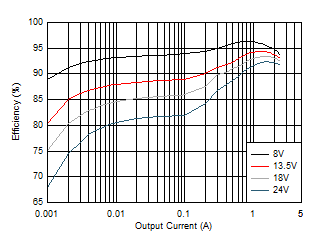
|
LM63625 |
VOUT
= 5 V |
ƒSW
= 400 kHz (AUTO) |
|
Figure 9-8 Efficiency. Unless otherwise specified, the following conditions apply: VIN
= 13.5 V, TA = 25°C. Table 9-4 shows the circuit with the appropriate BOM from Figure 9-44. 
| LM63615 |
VOUT = 5
V |
ƒSW = 400 kHz
(AUTO) |
Figure 9-10 Efficiency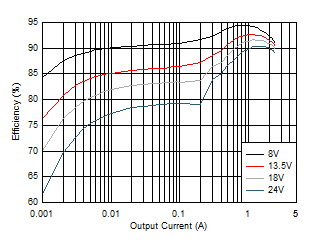
| LM63625 |
VOUT = 3.3
V |
ƒSW = 400 kHz
(AUTO) |
Figure 9-12 Efficiency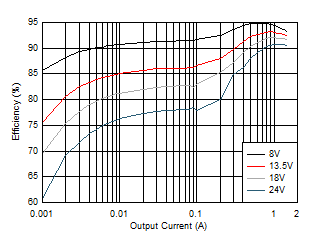
| LM63615 |
VOUT = 3.3
V |
ƒSW = 400 kHz
(AUTO) |
Figure 9-14 Efficiency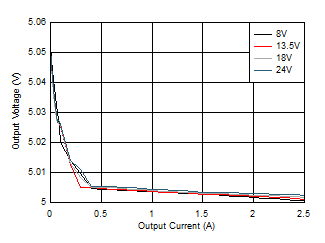
| LM63625 |
VOUT = 5
V |
ƒSW = 2100 kHz
(AUTO) |
Figure 9-16 Line
and Load Regulation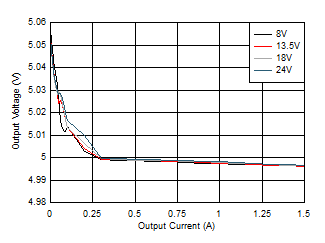
| LM63615 |
VOUT = 5
V |
ƒSW = 2100 kHz
(AUTO) |
Figure 9-18 Line
and Load Regulation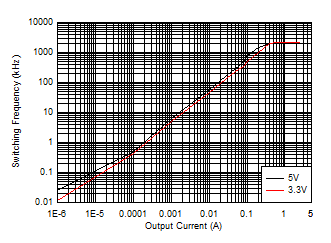
| LM63625 |
VIN = 13.5
V |
ƒSW = 2100 kHz
(AUTO) |
Figure 9-20 Switching Frequency versus Output Current
| LM63625 |
VOUT = 3.3
V |
ƒSW = 2100 kHz
(FPWM) |
Figure 9-22 Switching Frequency versus Input Voltage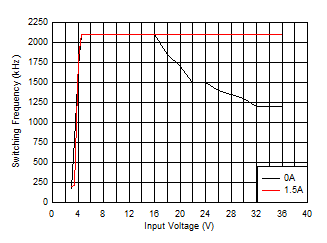
| LM63615 |
VOUT = 3.3
V |
ƒSW = 2100 kHz
(FPWM) |
Figure 9-24 Switching Frequency versus Input Voltage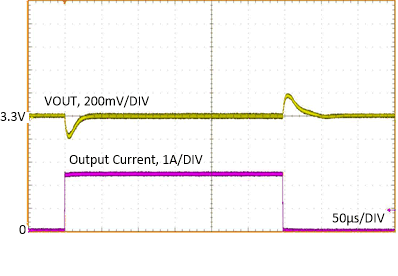
| LM63625 |
VOUT
= 3.3 V |
ƒSW
= 2100 kHz |
| 0 A to 2.5 A, 2 µs |
FPWM |
|
Figure 9-26 Load
Transient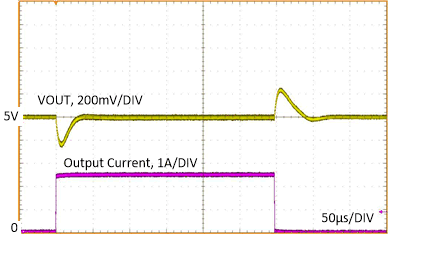
| LM63625 |
VOUT
= 5 V |
ƒSW
= 2100 kHz |
| 0 A to 2.5 A, 2 µs |
FPWM |
|
Figure 9-28 Load
Transient
| LM63625 |
VOUT
= 3.3 V |
ƒSW
= 2100 kHz |
| 1.5 A to 2.5 A, 2
µs |
AUTO |
|
Figure 9-30 Load
Transient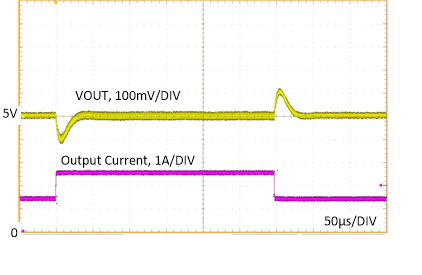
| LM63625 |
VOUT
= 5 V |
ƒSW
= 2100 kHz |
| 1.5 A to 2.5 A, 2
µs |
AUTO |
|
Figure 9-32 Load
Transient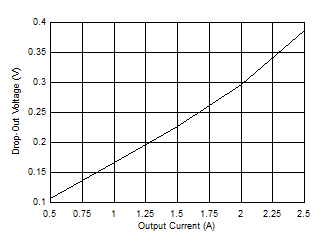
| LM63625 |
ƒSW = 140 kHz (AUTO) |
Figure 9-34 Dropout Voltage versus Output Current for -1% Drop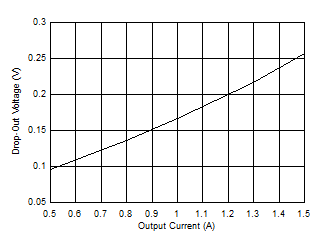
| LM63615 |
ƒSW = 140 kHz (AUTO) |
Figure 9-36 Dropout Voltage versus Output Current for -1% Drop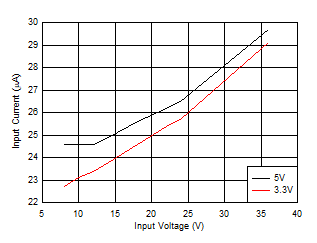
| LM63625 |
IOUT = 0
A |
ƒSW = 2100 kHz
(AUTO) |
Figure 9-38 Input
Supply Current versus Input Voltage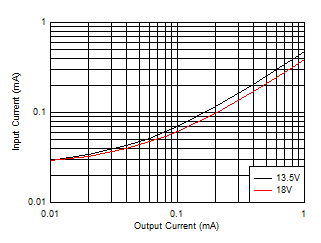
| LM63625 |
VOUT = 5
V |
ƒSW = 2100 kHz
(AUTO) |
Figure 9-40 Input
Supply Current versus Output Current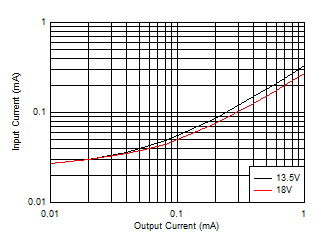
| LM63625 |
VOUT = 3.3
V |
ƒSW = 2100 kHz
(AUTO) |
Figure 9-42 Input
Supply Current versus Output Current
| LM63625 |
VOUT = 5
V |
ƒSW = 2100 kHz
(AUTO) |
Figure 9-9 Efficiency
| LM63615 |
VOUT = 5
V |
ƒSW = 2100 kHz
(AUTO) |
Figure 9-11 Efficiency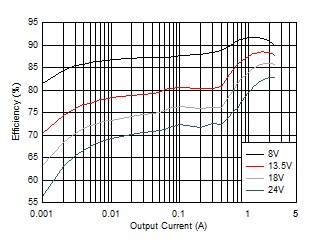
| LM63625 |
VOUT = 3.3
V |
ƒSW = 2100 kHz
(AUTO) |
Figure 9-13 Efficiency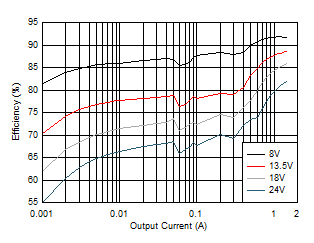
| LM63615 |
VOUT = 3.3
V |
ƒSW = 2100 kHz
(AUTO) |
Figure 9-15 Efficiency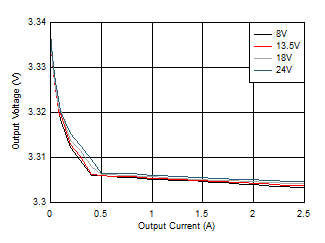
| LM63625 |
VOUT = 3.3
V |
ƒSW = 2100 kHz
(AUTO) |
Figure 9-17 Line
and Load Regulation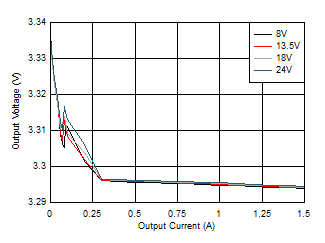
A.
| LM63615 |
VOUT = 3.3
V |
ƒSW = 2100 kHz
(AUTO) |
Figure 9-19 Line
and Load Regulation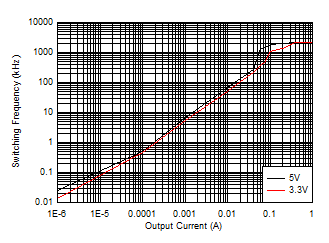
| LM63615 |
VIN = 13.5
V |
ƒSW = 2100 kHz
(AUTO) |
Figure 9-21 Switching Frequency versus Output Current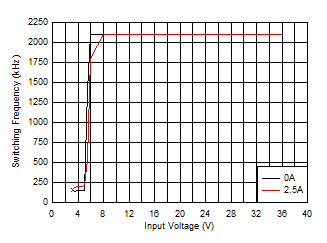
| LM63625 |
VOUT = 5
V |
ƒSW = 2100 kHz
(FPWM) |
Figure 9-23 Switching Frequency versus Input Voltage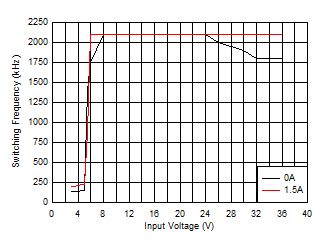
| LM63615 |
VOUT = 5
V |
ƒSW = 2100 kHz
(FPWM) |
Figure 9-25 Switching Frequency versus Input Voltage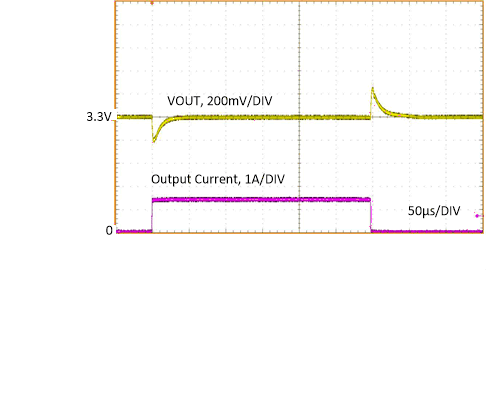
| LM63615 |
VOUT
= 3.3 V |
ƒSW
= 2100 kHz |
| 0 A to 1.5 A, 2 µs |
FPWM |
|
Figure 9-27 Load
Transient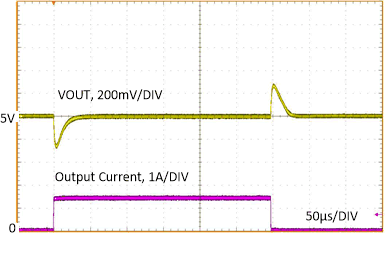
| LM63615 |
VOUT
= 5 V |
ƒSW
= 2100 kHz |
| 0 A to 1.5 A, 2 µs |
FPWM |
|
Figure 9-29 Load
Transient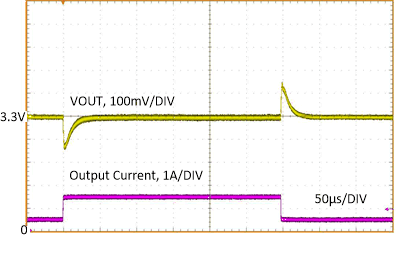
| LM63615 |
VOUT
= 3.3 V |
ƒSW
= 2100 kHz |
| 0.5 A to 1.5 A, 2
µs |
AUTO |
|
Figure 9-31 Load
Transient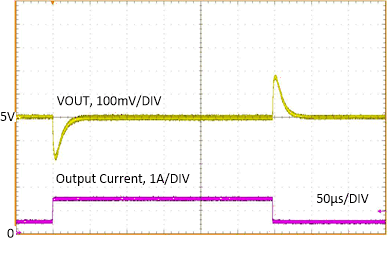
| LM63615 |
VOUT
= 5 V |
ƒSW
= 2100 kHz |
| 0.5 A to 1.5 A, 2
µs |
AUTO |
|
Figure 9-33 Load
Transient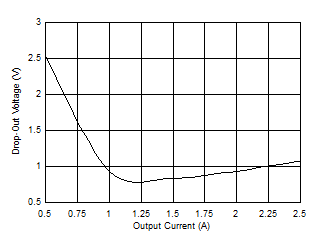
| LM63625 |
ƒSW = 1850 kHz (AUTO) |
Figure 9-35 Dropout Voltage versus Output Current to 1.85 MHz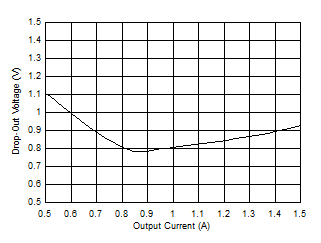
| LM63615 |
ƒSW = 1850 kHz (AUTO) |
Figure 9-37 Dropout Voltage versus Output Current to 1.85 MHz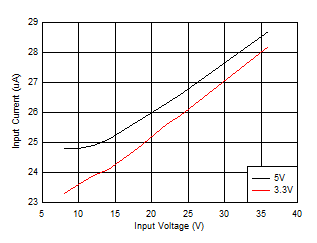
| LM63615 |
IOUT = 0
A |
ƒSW = 2100 kHz
(AUTO) |
Figure 9-39 Input
Supply Current versus Input Voltage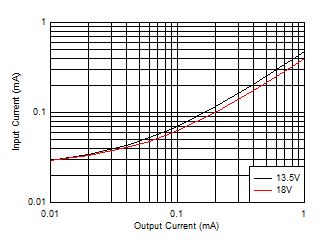
| LM63615 |
VOUT = 5
V |
ƒSW = 2100 kHz
(AUTO) |
Figure 9-41 Input
Supply Current versus Output Current
| LM63615 |
VOUT = 3.3
V |
ƒSW = 2100 kHz
(AUTO) |
Figure 9-43 Input
Supply Current versus Output CurrentUnless otherwise specified, the following conditions apply: VIN = 13.5 V,
TA = 25°C. Figure 9-44 shows the
circuit with the appropriate BOM from Table 9-4.
Table 9-4 BOM for Typical Application
Curves
| VOUT(1) |
FREQUENCY |
OUTPUT CURRENT |
COUT |
L |
U1 |
| 3.3 V |
400 kHz |
2.5 A |
3 × 22 µF |
6.8 µH, 22 mΩ |
LM63625D |
| 3.3 V |
2100 kHz |
2.5 A |
3 × 22 µF |
2.2 µH, 15 mΩ |
LM63625D |
| 5 V |
400 kHz |
2.5 A |
3 × 22 µF |
6.8 µH, 22 mΩ |
LM63625D |
| 5 V |
2100 kHz |
2.5 A |
3 × 22 µF |
2.2 µH, 15 mΩ |
LM63625D |
| 3.3 V |
400 kHz |
1.5 A |
2 × 22 µF |
10 µH, 40 mΩ |
LM63615D |
| 3.3 V |
2100 kHz |
1.5 A |
1 × 10 µF |
4.7 µH, 30 mΩ |
LM63615D |
| 5 V |
400 kHz |
1.5 A |
2 × 22 µF |
10 µH, 40 mΩ |
LM63615D |
| 5 V |
2100 kHz |
1.5 A |
1 × 10 µF |
4.7 µH, 30 mΩ |
LM63615D |
(1) The values in
this table were selected to enhance certain performance criteria and may not
represent typical values.





































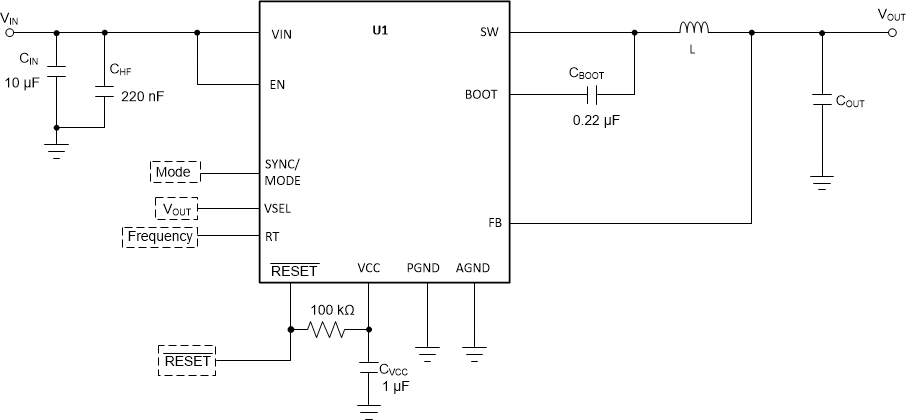 Figure 9-44 Circuit
for Typical Application Curves
Figure 9-44 Circuit
for Typical Application Curves